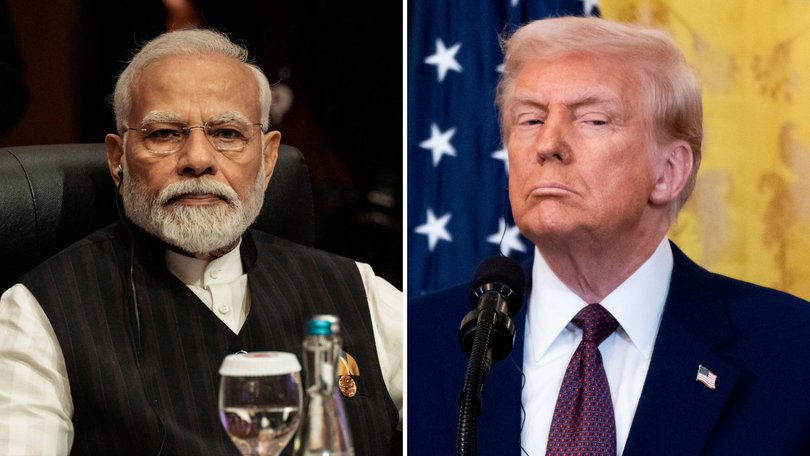India calls out EU and United States’ trade with Russia after Trump threatens steeper tariffs on New Delhi

India said it was being “targeted” by the US and the European Union over its imports of Russian oil after US President Donald Trump in an overnight social media post threatened New Delhi with much steeper tariffs.
India began importing oil from Russia only after “traditional supplies” were diverted to Europe following the outbreak of the Russia-Ukraine war in 2022, the country’s foreign ministry said in a statement late Monday.
The ministry called out the EU and the US saying, “it is revealing that the very nations criticising India are themselves indulging in trade with Russia. Unlike our case, such trade is not even a vital national compulsion [for them].”
Sign up to The Nightly's newsletters.
Get the first look at the digital newspaper, curated daily stories and breaking headlines delivered to your inbox.
By continuing you agree to our Terms and Privacy Policy.The EU’s bilateral trade with Russia stood at 67.5 billion euros ($AU120 billion) in 2024, while its services trade in 2023 was at 17.2 billion euros, according to European Commission data. Citing those numbers, India said the bloc’s trade was “significantly more” than India’s total trade with Russia.
Data from the Indian embassy in Moscow showed bilateral trade between New Delhi and Moscow reached a record $68.7 billion ($AU106 billion) for the year ended March 2025, nearly 5.8 times higher than the pre-pandemic trade of $10.1 billion.
The EU, meanwhile, was Russia’s third-biggest trade partner in 2024, accounting for 38.4 per cent of the country’s total global trade in goods, sliding from being Moscow’s top partner in 2020. EU’s goods trade with Russia dropped nearly 74 per cent in 2024 from 257.5 billion euros in 2021.
India’s response comes after Mr Trump threatened on Monday that he would be “substantially raising” the tariffs on India, although he did not specify the level of the higher tariffs.
The US President had threatened a 25 per cent duty on Indian exports, as well as an unspecified “penalty” last week.
He also accused India of buying discounted Russian oil and “selling it on the Open Market for big profits.”
Russia became the leading oil supplier to India since the war in Ukraine began, increasing imports from just under 100,000 barrels per day before the invasion, or a 2.5 per cent of its total imports, to more than 1.8 million barrels per day in 2023, or 39 per cent, according to the US Energy Information Administration’s report earlier this year.
“The United States at that time actively encouraged such imports by India for strengthening global energy markets stability,” the country said in its statement.
Eric Garcetti, when he was the US ambassador to India, said last year at a conference that India purchased Russian oil as “we wanted somebody to buy Russian oil.”
According to the International Energy Agency, 70 per cent of Russian crude was exported to India in 2024. India said oil imports were meant to ensure predictable and affordable energy costs to the Indian consumer.
India has in the past defended its oil purchases from Russia, with Hardeep Singh Puri, the country’s energy minister, saying in an interview last month with CNBC that New Delhi helped stabilise global energy prices and was encouraged by the US to do so.
“If people or countries had stopped buying at that stage, the price of oil would have gone up to 130 dollars a barrel. That was a situation in which we were advised, including by our friends in the United States, to please buy Russian oil, but within the price cap,” Mr Puri said.
India also took aim at the US, saying the country continues to import uranium hexafluoride for its nuclear industry, palladium for the electric-vehicle industry, as well as fertilisers and chemicals from Russia.
US bilateral trade with Russia in 2024 stood at $5.2 billion, compared with nearly $36 billion in 2021, government data showed. The US has not imposed any “reciprocal tariffs” on Russia.
“In this background, the targeting of India is unjustified and unreasonable. Like any major economy, India will take all necessary measures to safeguard its national interests and economic security,” New Delhi said.
Speaking to CNBC’s “Squawk Box Asia,” Rachel Ziemba, adjunct senior fellow at the Center for a New American Security, said that some of India’s concerns were justified. “It was the last U.S. administration that put in place the price cap system, which facilitated the redirection of trade.”
Ms Ziemba also said India is caught in a “crossfire” of difficult trade talks.
